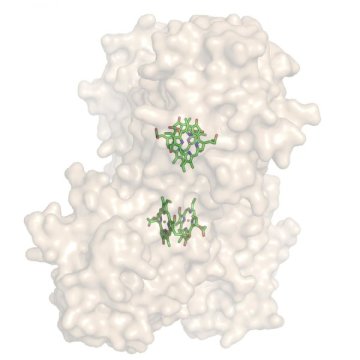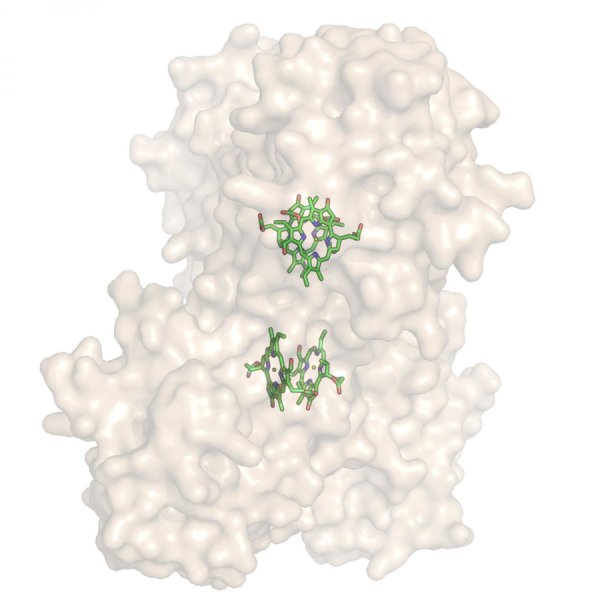[ad_1]

Water-soluble Chlorophyll Protein tetramer binding four chlorophylls (in green).
Credit: Ill./©: Alessandro Agostini, JGU
Whenever you see green color out in nature, you are likely to look at chlorophyll. This is the pigment used by all plants to do photosynthesis. There are two versions, chlorophyll a and chlorophyll b. These are structurally very similar to one another but have different colors, blue-green and yellowish green, respectively. Both pigments fulfill different jobs during photosynthesis and therefore are bound very selectively by the proteins of the photosynthesis apparatus in plants. How these plant proteins recognize the two chlorophylls, despite their small structural differences, and thus are able to bind them selectively, has been largely unknown so far.
Researchers of Johannes Gutenberg University Mainz (JGU), together with two Japanese colleagues, have partially solved this riddle. The team of Professor Harald Paulsen at the JGU Faculty of Biology used the so-called Water-soluble Chlorophyll Protein of cauliflower and Virginia pepperweed as a model protein. This protein possesses only a single chlorophyll binding site per protein molecule and is able to bind both chlorophyll versions. Upon variation of the amino acids near the chlorophyll binding site, the preference of the protein for one chlorophyll or the other changed. In one case, exchanging a single amino acid altered the relative binding strengths by a factor of 40. “This does not explain everything about Chl a/b binding specificity in the photosynthetic apparatus,” said Paulsen, “but our results yield useful hypotheses that now can be tested with photosynthesis proteins. In the longer run, this may help to improve light harvesting in new photovoltaic devices or in artificial photosynthesis.”
One of the lead authors of this publication in Nature Plants is Dr. Alessandro Agostini. He received his doctorate for his thesis on Water-soluble Chlorophyll Protein jointly from Mainz University (Paulsen group) and the University of Padova in Italy (group of Professor Donatella Carbonera). “This is a nice example of a successful international collaboration,” added Paulsen, “not only in terms of research but also by jointly advising a graduate student.” This work was funded by the German Research Foundation.
Story Source:
Materials provided by Johannes Gutenberg Universitaet Mainz. Note: Content may be edited for style and length.
Journal Reference:
- Daniel M. Palm, Alessandro Agostini, Vivien Averesch, Philipp Girr, Mara Werwie, Shigekazu Takahashi, Hiroyuki Satoh, Elmar Jaenicke, Harald Paulsen. Chlorophyll a/b binding-specificity in water-soluble chlorophyll protein. Nature Plants, 2018; DOI: 10.1038/s41477-018-0273-z
Cite This Page:
Johannes Gutenberg Universitaet Mainz. “How plants bind their green pigment chlorophyll: Water-soluble protein helps to understand the photosynthetic apparatus.” . , 18 October 2018. <www..com/releases/2018/10/181018105325.htm>.
Johannes Gutenberg Universitaet Mainz. (2018, October 18). How plants bind their green pigment chlorophyll: Water-soluble protein helps to understand the photosynthetic apparatus. . Retrieved October 18, 2018 from www..com/releases/2018/10/181018105325.htm
Johannes Gutenberg Universitaet Mainz. “How plants bind their green pigment chlorophyll: Water-soluble protein helps to understand the photosynthetic apparatus.” . www..com/releases/2018/10/181018105325.htm (accessed October 18, 2018).
[ad_2]















